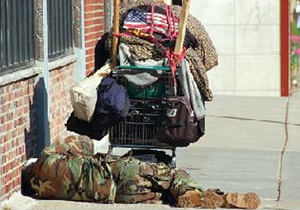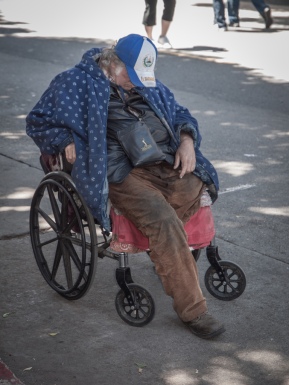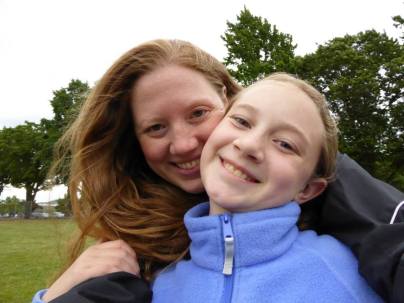Solving Chronic Homelessness with Permanent Homes
By Jessica Reid
On any given night in the United States, there are roughly 578,000 people who experience homelessness. Of this 578,000, 15% of these people are classified as chronically homeless (Snapshot of Homelessness, 2015). This 15%, which amounts to about 86,700 people, are defined by the United States Department of Housing and Urban Development (HUD) as individuals who have been homeless for over a year or have had four episodes of homelessness over the last three years. In addition, they must also have a disability (HUD, 2007). Most of these individuals suffer from mental illness, substance abuse, or other physical disabilities. Though the chronically homeless account for a small percentage of the homeless, they cost the public the most in resources and are the most vulnerable and at risk subset of the homeless population. Surprisingly, the solution to ending chronic homelessness is relatively simple. Providing permanent, no-strings-attached housing for the chronically homeless is not only the most humane solution but also the most cost-effective for ending chronic homelessness. This idea is called Housing First.
The quickest way to gain support for the Housing First movement is to talk numbers. The cost to the public for the chronically homeless average from $30,000 to $50,000 per person, per year (United States Interagency Council on Homelessness, 2015). Taking the lower number of $30,000, that means that nationally we are looking at a minimum annual cost to the public of $2.6 billion dollars. Where do the costs come from? From the repeated use of emergency rooms, hospitals, jails, psychiatric centers, detox and other crisis services. What’s worse is that this reactionary approach does little to improve the long-term health or well-being of the chronically homeless, nor does it approach a morally sound solution in providing for the basic needs of our citizens. $2.6 billion dollars later you still have our most at-risk homeless population living and sleeping on the streets, in shelters, hospitals, or jails.
Additionally, this ineffective approach reduces access to services and funding to the 85% of those individuals experiencing short-term homelessness. It unnecessarily overburdens our hospitals, police force, and prison systems. In Utah, for example, the chronically homeless constitute only 5% of the homeless population but consume 50% of the resources for homeless services (Comprehensive Report On Homelessness, 2014).
There are many reasons to focus on chronic homelessness. The first is to end homelessness for those who have become the most vulnerable and improve their safety and quality of life. The second is the cost savings to the community from use of emergency services such as emergency rooms and jails. A third objective is to increase the capacity in emergency shelters. Although this population comprises less than 5 percent of the total homeless population, they consume about 50 percent of the resources for homeless services.
(Comprehensive Report on Homelessness, 2014)
Housing First approaches the problem of chronic homelessness differently from prior systems. Prior systems operate under the do first, then receive model. Housing is earned. Though good in its intention, the system is patronizing and often fails. The homeless are required to meet certain standards of stability before they can receive assistance. They must prove they are sober, attend required meetings, maintain a job, etc. Once they can show stability, they are eligible for housing assistance.
The problem with the approach of earning assistance is two-fold. One, some people are incapable of earning housing according to current social standards. They are either unable to overcome their addiction or maintain employment due to their mental illness or disability. Two, it is incredibly difficult (sometimes, impossible) to obtain and sustain stability in sobriety, mental health, or employment without a permanent home. To obtain a job, a candidate must be clean and have clean clothing. Without access to toilets, showers, and laundry facilities, this poses a true challenge. There are relatively few places that allow public access to toilets, showers and laundry services without payment. Obtaining food and a safe and warm place to sleep are also daily challenges that create incredible stress. The stress, in addition to a feeling of hopelessness and helplessness, can often exacerbate any tendencies towards addictive behavior. Also, consider that in today’s world, in order to apply for jobs you must have access to a computer and the Internet, access to a phone and an email account, and the technological skills to use them. Unlike the majority of the homeless, the chronically homeless often lack the capabilities that are necessary to meet these requirements, which are considered necessary to earn assistance with housing. Thus, they remain homeless. After seeing the failure in this system, the idea of Housing First emerged.
The Housing First concept was pioneered by Dr. Sam Tsemberis of the New York University of Medicine in 1992 under the Pathways to Housing program for homeless adults with psychiatric disabilities and addiction disorders. The concept is quite simple:
Provide housing first, and then combine that housing with supportive treatment services in the areas of mental and physical health, substance abuse, education, and employment. Housing is provided in apartments scattered throughout a community. This ‘scattered site’ model fosters a sense of home and self-determination, and it helps speed the reintegration of Pathways clients into the community.
(Housing First Model, 2015)
The system works. Not only does the system have an extremely high retention rate but it is cost-effective. Providing permanent housing to the chronically homeless costs less than the $2.6 billion that we are already spending. Housing First programs have begun springing up all over the United States and the cost savings are immediate. In Seattle, a Housing First program was created for homeless men and women facing chronic alcohol addiction. During the first year of operation, the program saved taxpayers 4 million dollars. In Denver, there was a decrease from $43,239 in emergency costs per person to $11,694 after being placed in a Housing First program. A cost savings of 79% over a 24 month period. If the Housing First program was extended to all 513 chronically homeless individuals in Denver the savings, after investments, are estimated at 2.4 million dollars per year (Denver Housing First Collaborative, 2015).
Although enormously successful, these programs have been small in focus and conducted as trial programs in individual cities. Much of the resistance is due to requiring a change in conventional wisdom and assumptions that previous models for dealing with the homeless have encompassed. In 2005, Utah implemented a statewide Housing First program to end chronic homelessness in 10 years.
How Utah accomplished this didn’t require complex theorems or statistical models. But it did require the suspension of what had been conventional wisdom. For years, the thought of simply giving the homeless homes seemed absurd, constituting the height of government waste. Many chronically homeless, after all, are victims of severe trauma and significant mental health and addiction issues. Many more have spent thousands of nights on the streets and are no longer familiar with home-living. Who, in their right mind, would willingly give such folk brand new houses without any proof of marked improvement? But that’s exactly what Utah did. “If you want to end homelessness, you put people in housing,” Walker said in an interview. “This is relatively simple.”
(McCoy, 2015)
As of April 2015, the number of chronically homeless individuals in Utah has dropped from 1,932 to 178, a reduction of 91% (Semerad, 2015). Officials are working with the remaining 178. “We know these individuals by name, know their situation, and we can help them move out of chronic homelessness, if they choose,” said Gordon Walker, director of the state Housing and Community Development Division (Glionna, 2015). The costs for providing housing and services in Utah through Housing First is $11,000 per person versus the $17,000 average in costs for those on the street (Glionna, 2015). Walker says that the annual savings are $8,000 per person (McCoy, 2015). Multiplying the savings of $8,000 per person to the 1,754 chronically homeless in Utah that have received housing creates an annual taxpayer savings of 14 million dollars.
Housing First is also able to boast high retention rates, consistently between 85-90%, even for individuals who have not succeeded in other programs (Housing First Model, 2015). There are other benefits as well. Colorado found that 50% of participants experienced improvement in their health, 43% had improved mental health, 15% had reduced their substance use, and 64% improved their overall quality of life. In fact, the programs are so successful that in 2014, Canada adopted the Housing First model as its national policy to end homelessness (Housing First Model, 2015).
Another group that has adopted the Housing First policy is the United States Department of Veterans Affairs. This program is being initiated for all homeless Veterans, chronically homeless or not. Before making Housing First the official policy for addressing homelessness in the Veteran population, the VA ran a pilot program with 177 Veterans. The program sought to contrast the results of the Housing First model with the standard policy of requiring “housing readiness”. In the Housing First group, Veterans were moved into housing within 35 days versus 235 days if they had to show housing readiness. Housing retention rates were significantly higher and emergency room use declined significantly. In October of 2012, the VA adopted a three-year evaluation pilot program using the Housing First model at 14 program sites (Housing First, 2015). In the first two years of implementing this program, almost 100,000 individuals received assistance. After being housed, only 15% returned to homelessness two years after exiting the program (Fact Sheet: Veteran Homelessness, 2015). There was a 14% decline in Veteran Homelessness from 2013 to 2014 and a 33% decline in 2014 compared
to 2009 (Veterans, 2015).

Let’s be realistic and recognize that providing housing for the chronically homeless is not going to be a magical solution. There is no assurance (nor requirement) that the individual will recover from their substance abuse, nor that there will be a significant improvement in their mental illness, if they have one. Housing First does, however, provide a humane and cost-effective way of getting the homeless that are mentally ill, disabled, or battling addictions, off the streets and away from businesses and tourists. It is also more effective at integrating the chronically homeless back into their communities, rather than as social outcasts. Housing First stops the cycle of dehumanizing the chronically homeless. It relieves community systems, resources, and finances to focus on the larger homeless population, those who have fallen on temporary hard times and are capable of stabilizing their lives with minor assistance. By caring for and reducing costs in providing care and support for the chronically homeless we will better improve our abilities to support the 85% of the homeless population that there are far too little resources for.
Sources
Comprehensive Report on Homelessness. (2014). https://jobs.utah.gov/housing/scso/documents/homelessness2014.pdf
Defining Chronic Homelessness: A Technical Guide for HUD Programs. (2007, September 1).
Retrieved from
Click to access DefiningChronicHomeless.pdf
Denver Housing First Collaborative: Executive Summary. (n.d.). Retrieved November 17, 2015, from
Click to access Executive_Summary_DHFC_study.pdf
Fact Sheet: Veteran Homelessness. (2015, April 22). Retrieved from
http://www.endhomelessness.org/library/entry/fact-sheet-veteran-homelessness
Glionna, J. (2015, May 24). Utah is winning the war on chronic homelessness with ‘Housing First’
program. Retrieved from
http://www.latimes.com/nation/la-na-utah-housing-first-20150524-story.html
Housing First. (n.d.). Retrieved November 18, 2015, from
http://www.endveteranhomelessness.org/programs/housing-first-pilot
Housing First Model. (n.d.). Retrieved November 20, 2015, from
https://pathwaystohousing.org/housing-first-model
McCoy, T. (2015, April 17). The surprisingly simple way Utah solved chronic homelessness and saved
millions. Retrieved from
https://www.washingtonpost.com/news/inspired-life/wp/2015/04/17/the-surprisingly-simple-way-utah-solved-chronic-homelessness-and-saved-millions/
Semerad, T. (2015, April 28). Utah’s chronic homeless numbers drop from 1,932 to 178 in 10 years.
Retrieved from
http://www.sltrib.com/news/2448407-155/utah-hails-drop-in-chronic-homeless
Snapshot of Homelessness. (n.d.). Retrieved November 17, 2015, from
http://www.endhomelessness.org/pages/snapshot_of_homelessness
United States Interagency Council on Homelessness. (n.d.). Retrieved November 16, 2015, from
http://usich.gov/population/chronic
Veterans. (n.d.). Retrieved November 18, 2015, from
http://www.endhomelessness.org/pages/veterans









 Ever since I was a child I wanted to ‘do something’ with my life that would ‘make a difference’. I was never able to quantify what that was. These are my initial steps in aligning myself towards that vision to make a difference in whatever small ways I can. Now, I recognize that a couple week trip to another country isn’t going to ‘make a difference’ in any tangible, earth shattering way, but it will likely make a difference to me. To my outlook. To my limited, narrow, unexperienced view of the world.
Ever since I was a child I wanted to ‘do something’ with my life that would ‘make a difference’. I was never able to quantify what that was. These are my initial steps in aligning myself towards that vision to make a difference in whatever small ways I can. Now, I recognize that a couple week trip to another country isn’t going to ‘make a difference’ in any tangible, earth shattering way, but it will likely make a difference to me. To my outlook. To my limited, narrow, unexperienced view of the world.
 I honestly can’t say that I ever saw myself becoming a hiker. Or a runner. Or someone who would fly helicopters, planes, or jump out of them for that matter. It’s all part of a discovery process that has been incredibly powerful and healing. I was the person who had intangible dreams, lots of ‘maybe someday’ items collecting dust in a bucket that was never going anywhere. I watched life happen, I didn’t live it. The realization that you can redefine and shift your purpose and direction, at any point in life, is probably the most empowering thing I’ve ever learned. This drive to challenge myself in letting go of this thought that I’ll never be ‘this’ or ‘that’ has grown right up alongside my desire to see the world, and become a global volunteer. It will still be awhile until I am an RN and capable of making any real significant volunteer impact but I’m not going to let that stop me in making whatever difference I can make at this stage in life.
I honestly can’t say that I ever saw myself becoming a hiker. Or a runner. Or someone who would fly helicopters, planes, or jump out of them for that matter. It’s all part of a discovery process that has been incredibly powerful and healing. I was the person who had intangible dreams, lots of ‘maybe someday’ items collecting dust in a bucket that was never going anywhere. I watched life happen, I didn’t live it. The realization that you can redefine and shift your purpose and direction, at any point in life, is probably the most empowering thing I’ve ever learned. This drive to challenge myself in letting go of this thought that I’ll never be ‘this’ or ‘that’ has grown right up alongside my desire to see the world, and become a global volunteer. It will still be awhile until I am an RN and capable of making any real significant volunteer impact but I’m not going to let that stop me in making whatever difference I can make at this stage in life.

 4. Sometimes your vulnerability is going to get you hurt. Really, really, hurt. It’s still worth the pain. Walk away. Learn the lesson. Be vulnerable again.
4. Sometimes your vulnerability is going to get you hurt. Really, really, hurt. It’s still worth the pain. Walk away. Learn the lesson. Be vulnerable again.


